2016 Summer
|
THE WINTER 2016 MAP IS NOW ACTIVE. Flow (the green track) has spent most of the summer along the Merrimack River, about 18 mi. west of his nest, where he was grew up in 2014.
Don't forget to refresh your browser to be sure to catch the latest updates (below the map).
|
All Birds - Summer 2016 (15 April - 1 September)Holly (yellow), Adult female tagged with her mate, Hacket, at her nest in Annapolis, MD. on 3 May 2016. Hackett (orange), Adult male trapped at his Annapolis, MD, nest along with his mate, Holly, on 3 May 2016. His dot may be behind Holly's-or vice versa. Zoom in to see both. Staddler (dark blue), Adult male, back on his nest in Hampton, NH, after wintering along the Amazon River in Brazil. Wausau (aqua) Adult male, wintered in Venezuela and returned to his nest in Groveton in northern NH. Belle (pink), Martha's Vineyard soon-to-be 6-yr old female(?). Nick (red), Adult male, tagged in 2013, back on his nest on Tangier Island in Chesapeake Bay after another winter in northenn Colombia. Flow (green), (About to make 1st trip north). Essex, MA, soon-to-be 2-yr old male. Newly tagged in NewfoundlandShanawdithit (dk blue), Adult female, mother of Virginia and Jocelyn. St. John's, Newfoundland. Tagged 24 Aug. Began migration 16 Sep. Virginia (orange), Juv. female, daughter of Shanawdithit. St. John's, NL. Tagged 24 Aug. Began migration 4 Oct. Died 7 Oct in South Carolina. Jocelyn (yellow), Juv. female. St. John's, NL. Tagged 24 Aug. Died after collision on 27 Sep or so. Daphne (white), Ad. female. St. John's, NL. Tagged 25 Aug. Began migration 2 Sep. Maybe done 17 Oct in Panama. Leif Erikson (teal), Juv. male. St. John's, NL. Tagged 25 Aug. Began mirgrating on 15 Sept. Trepassey (gold), Juv. female. Trepassey, NL. Tagged 26 Aug. Last signal 11 Sep.
Notes: Hover the cursor over a dot to see which bird is which. Click on it for location details You can zoom in and out and move the map around. If you slide a birds marker along its path, you'll see where the other birds were when your bird was wherever you have the marker. You can also use the calendar to see where all the birds were on a given date. Go to Individual Bios |
15 August
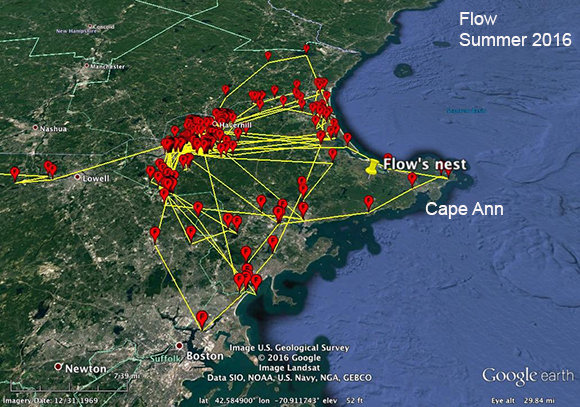 It has been a typically slow summer, which is the way we like it. Flow, on his first summer back in North America, has been concentrating his fishing along the Merrimack River in northeastern Massachusetts. He made a road trip out to Cape Ann on August 2nd. At one point in the the trip, he was about 2 miles from his nest, but that was it. There's been no sign of any interest in returning to his natal marsh. This has been the pattern we've seen with juveniles returning on their first trip north. Belle is behaving just as (s)he has in previous years. She's based at Cape Cod's Long Pond in Falmouth. Early in the summer she commutes a lot to Martha's Vineyard. Later in the summer she visits Marion and Mattapoisett on the western side of Buzzards Bay. Maybe next year Belle will find a mate. We hope her radio keeps working. She's had it for 6 years, and it was out on another bird before Belle got it, so we sort of feel like we're on borrowed time with it. Snowy, tagged a year after Belle in 2011, is no longer on the map--the antenna on his radio broke late in the spring--but we've had recent photos of him on his nest on Nantucket. Next year we'll get over there and try to trap him to get the radio off his back. Wausau's nest failed up in northern New Hampshire. The female seems to have disappeared. In southern New Hampshire, Staddler had 2 healthy young in his nest when Iain MacLeod and I visited the Hampton Beach marshes on July 15th.
It has been a typically slow summer, which is the way we like it. Flow, on his first summer back in North America, has been concentrating his fishing along the Merrimack River in northeastern Massachusetts. He made a road trip out to Cape Ann on August 2nd. At one point in the the trip, he was about 2 miles from his nest, but that was it. There's been no sign of any interest in returning to his natal marsh. This has been the pattern we've seen with juveniles returning on their first trip north. Belle is behaving just as (s)he has in previous years. She's based at Cape Cod's Long Pond in Falmouth. Early in the summer she commutes a lot to Martha's Vineyard. Later in the summer she visits Marion and Mattapoisett on the western side of Buzzards Bay. Maybe next year Belle will find a mate. We hope her radio keeps working. She's had it for 6 years, and it was out on another bird before Belle got it, so we sort of feel like we're on borrowed time with it. Snowy, tagged a year after Belle in 2011, is no longer on the map--the antenna on his radio broke late in the spring--but we've had recent photos of him on his nest on Nantucket. Next year we'll get over there and try to trap him to get the radio off his back. Wausau's nest failed up in northern New Hampshire. The female seems to have disappeared. In southern New Hampshire, Staddler had 2 healthy young in his nest when Iain MacLeod and I visited the Hampton Beach marshes on July 15th.
26 June
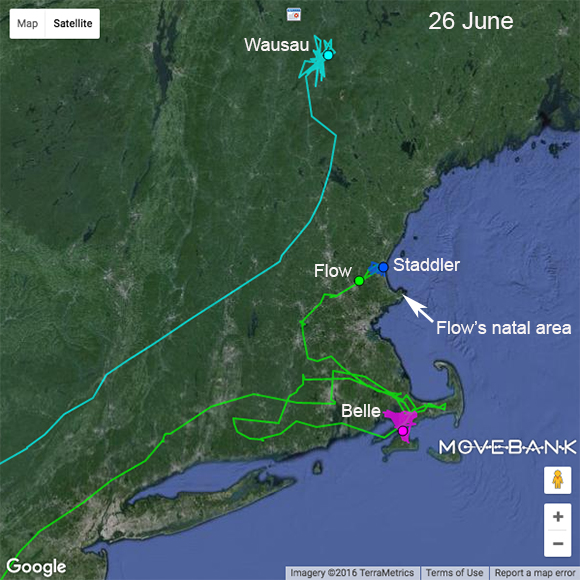 Flow left his winter (and summer and winter) retreat in Cuba on 27 April, which is not unexpected in a juvenile on its first trip north.
On 22 June, he wandered into the home range of our adult male Staddler
up in the Seabrook/Hampton Beach marshes. This was after he visited Belle's stomping grounds in the southwestern corner of Cape Cod. Belle continues to visit Martha's Vineyard his/her birthplace and is now commuting across Buzzards Bay to Marion and Mattapoisett in southeastern coastal MA. This is just what Belle has been doing for 5 years. Still no sign of bonding to a site. Over on Nantucket, Snowy, no longer broadcasting due to a broken antenna, lost the eggs or young that seemed to have been in the nest, based on his brooding, photographed by Trish Pastuszak. Now he's hanging around, so he's claimed the turf and should be in good shape. Too bad we won't know whether he'll spend his winter in Cuba or Venezuela. He is the only Osprey that's ever been tagged to have two wildly different winter locations.
Flow left his winter (and summer and winter) retreat in Cuba on 27 April, which is not unexpected in a juvenile on its first trip north.
On 22 June, he wandered into the home range of our adult male Staddler
up in the Seabrook/Hampton Beach marshes. This was after he visited Belle's stomping grounds in the southwestern corner of Cape Cod. Belle continues to visit Martha's Vineyard his/her birthplace and is now commuting across Buzzards Bay to Marion and Mattapoisett in southeastern coastal MA. This is just what Belle has been doing for 5 years. Still no sign of bonding to a site. Over on Nantucket, Snowy, no longer broadcasting due to a broken antenna, lost the eggs or young that seemed to have been in the nest, based on his brooding, photographed by Trish Pastuszak. Now he's hanging around, so he's claimed the turf and should be in good shape. Too bad we won't know whether he'll spend his winter in Cuba or Venezuela. He is the only Osprey that's ever been tagged to have two wildly different winter locations.
16 June
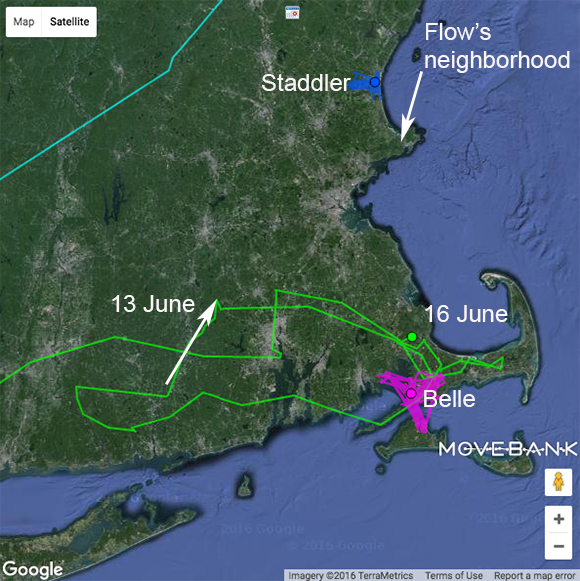 Flow got to central Connecticut on the 7th of June and then spent some time on Cape Cod. He circled back to Connecticut via the Elizabeth Islands on 10th. On the 13th it looked like he was lined up to make a trip to his home town in Essex Co., MA. But then he changed his mind and went back to the western Cape. His theme song has to be Ginger Baker from Blind Faith singing "I can't find my way home"! He's been to some of the ponds that Belle (the pink track) has been visiting for years. I wonder if they've bumped into each other and recounted the stories of the day they landed on their nests hoping to eat a fish and wound up with a transmitter instead.
Flow got to central Connecticut on the 7th of June and then spent some time on Cape Cod. He circled back to Connecticut via the Elizabeth Islands on 10th. On the 13th it looked like he was lined up to make a trip to his home town in Essex Co., MA. But then he changed his mind and went back to the western Cape. His theme song has to be Ginger Baker from Blind Faith singing "I can't find my way home"! He's been to some of the ponds that Belle (the pink track) has been visiting for years. I wonder if they've bumped into each other and recounted the stories of the day they landed on their nests hoping to eat a fish and wound up with a transmitter instead.
Down on the Chesapeake, Holly and Hackett did not have eggs on a recent check and probably will not, but they're definitely committed to the nest. Maybe next year.
Further south, in the Virginian portion of Chesapeake Bay, we've sent some spies over to Tangier Island to see what's up with Nick. Field reports were inconclusive. He's definitely spending a lot of time at a platform close to the one he was nesting on in 2013 when we tagged him, but we don't know if he has a family or not.
In New Hampshire, things look good for Staddler down on the coast in Hampton Beach, just based on how much time he's spending at his nest, but on a recent visit Iain MacLeod made to Wausau's nest, Wausau seemed to be tending to the nest alone. We're worried about the female.
Still no nest for Belle, but (s)he has visited Sengekontacket Pond and the Felix Neck Sanctuary over on Martha's Vineyard 10 times. Nice real estate move if it works out!
4 June
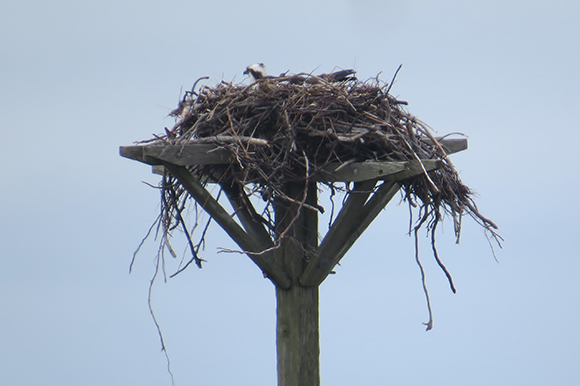 Finally! A picture of Snowy apparently incubating on his nest over on Nantucket. We're so excited. This is our first tagged young to have made it to breeding. Sadly, our latest report from Nantucket indicates that there are no longer eggs or young in the nest. But Snowy is hanging around, so he should return next year to try again.
His antenna broke off (one can just see the base of it protruding from the transmitter on his back) so we aren't getting signals from him, but Trish Pastuszak has been watching and providing a play-by-play summary, as well as photos, of the action at his new nest. We may get over to Nantucket this summer and see if we can retrap him and relieve him of the transmitter. Normally I'd just swap the transmitter for a color band on his leg, but he's been so interesting with winter homes in both Cuba and Venezuela (used in alternate years) that it's tempting to give him a new transmitter. But I don't have a spare to use and it's late to get one lined up, so we'll probably not do it.
Finally! A picture of Snowy apparently incubating on his nest over on Nantucket. We're so excited. This is our first tagged young to have made it to breeding. Sadly, our latest report from Nantucket indicates that there are no longer eggs or young in the nest. But Snowy is hanging around, so he should return next year to try again.
His antenna broke off (one can just see the base of it protruding from the transmitter on his back) so we aren't getting signals from him, but Trish Pastuszak has been watching and providing a play-by-play summary, as well as photos, of the action at his new nest. We may get over to Nantucket this summer and see if we can retrap him and relieve him of the transmitter. Normally I'd just swap the transmitter for a color band on his leg, but he's been so interesting with winter homes in both Cuba and Venezuela (used in alternate years) that it's tempting to give him a new transmitter. But I don't have a spare to use and it's late to get one lined up, so we'll probably not do it.
4 May 2016
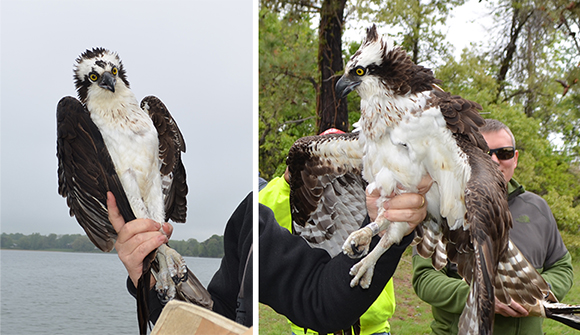 Meet Hackett (on the left) and Holly, a presumably young pair of Ospreys that has set up on a new pole on Hackett Point just south of the Annapolis end of the Chesapeake Bay Bridge. The pole they're on is a replacement for the pole that our 2013 male, Woody, and his mate used. That pole, already at a 45-degree angle, was swept away by ice floes in the winter of 2014-2015. Inexplicably, Woody returned to the Bay last year but did not nest. A pair was in residence when he arrived--perhaps the two birds we trapped and tagged on 3 May of this year--and he was not willing (unlikely) or able (also surprising as the resident male) to reclaim his corner of the Bay. He died later that summer, presumably a traffic fatality. When we arrived this spring to set our trap, the two birds at the replacement pole had not yet laid eggs. I've never trapped adults at a nest without eggs or young, so I was more than a bit skeptical of our chances of catching even one of the pair. We went ahead and set the noose carpet over 3 dummy Osprey eggs (imagine the female's surprise when she returned to the nest to see it full of eggs. Hmmm, she thought, now that was easy!) and 3 menhaden (one of the Osprey's favorite prey items). Oh, ye of little faith! 18 minutes after we pulled away from the nest, we had trapped both birds! We outfitted both of them with cell-tower transmitters and will now get to watch to see how they do this season. It's quite late to be laying, but if this is a young pair, that's not too unusual. Because we've got both the male and female tagged, it will be easy to tell if she lays eggs. Once that happens, almost all her locations will be at the nest.
Meet Hackett (on the left) and Holly, a presumably young pair of Ospreys that has set up on a new pole on Hackett Point just south of the Annapolis end of the Chesapeake Bay Bridge. The pole they're on is a replacement for the pole that our 2013 male, Woody, and his mate used. That pole, already at a 45-degree angle, was swept away by ice floes in the winter of 2014-2015. Inexplicably, Woody returned to the Bay last year but did not nest. A pair was in residence when he arrived--perhaps the two birds we trapped and tagged on 3 May of this year--and he was not willing (unlikely) or able (also surprising as the resident male) to reclaim his corner of the Bay. He died later that summer, presumably a traffic fatality. When we arrived this spring to set our trap, the two birds at the replacement pole had not yet laid eggs. I've never trapped adults at a nest without eggs or young, so I was more than a bit skeptical of our chances of catching even one of the pair. We went ahead and set the noose carpet over 3 dummy Osprey eggs (imagine the female's surprise when she returned to the nest to see it full of eggs. Hmmm, she thought, now that was easy!) and 3 menhaden (one of the Osprey's favorite prey items). Oh, ye of little faith! 18 minutes after we pulled away from the nest, we had trapped both birds! We outfitted both of them with cell-tower transmitters and will now get to watch to see how they do this season. It's quite late to be laying, but if this is a young pair, that's not too unusual. Because we've got both the male and female tagged, it will be easy to tell if she lays eggs. Once that happens, almost all her locations will be at the nest.
3 May 2016
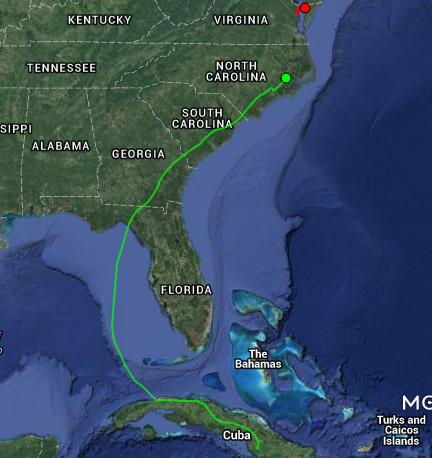 Flow, a male tagged as a juvenile at his nest in Essex Co., MA, finally left his reservoir in central Cuba and is on his way home. He left on 27 April, which was not the latest one of our tagged "teenagers" have started their first trip north (Conomo, another young male who wintered in Cuba, started north on 8 May), but close to it. Flow, like many first-timers before him, missed the turn in Cuba that would have gotten him to the Florida Keys. Instead, he continued west until just past Havanna, where he ran out of land. The shoreline turns southwest at that point, so to continue heading north, he had to cross the Gulf of Mexico, which he did. His crossing was about 520 miles (840 km), arriving on the Florida panhandle south east of Tallahassee in the pre-dawn hours of the 30th. Past the fish farms of Cuba and the dangers of an over-water crossing, he now has to avoid spending the night in a woodlot occupied by a hungry Great-horned Owl as he works his way north to northeastern Massachusetts. He's now in eastern North Carolina and I'm about to head to western NC to teach my ornithology class at the Highlands Biological Station. Our paths won't exactly cross, but it'll be close.
Flow, a male tagged as a juvenile at his nest in Essex Co., MA, finally left his reservoir in central Cuba and is on his way home. He left on 27 April, which was not the latest one of our tagged "teenagers" have started their first trip north (Conomo, another young male who wintered in Cuba, started north on 8 May), but close to it. Flow, like many first-timers before him, missed the turn in Cuba that would have gotten him to the Florida Keys. Instead, he continued west until just past Havanna, where he ran out of land. The shoreline turns southwest at that point, so to continue heading north, he had to cross the Gulf of Mexico, which he did. His crossing was about 520 miles (840 km), arriving on the Florida panhandle south east of Tallahassee in the pre-dawn hours of the 30th. Past the fish farms of Cuba and the dangers of an over-water crossing, he now has to avoid spending the night in a woodlot occupied by a hungry Great-horned Owl as he works his way north to northeastern Massachusetts. He's now in eastern North Carolina and I'm about to head to western NC to teach my ornithology class at the Highlands Biological Station. Our paths won't exactly cross, but it'll be close.
26 April 2016
 Our favorite Osprey gadfly Edwin died around 12 April. Office Joshua Tefft of the CT State Environmental Protection Police came across Edwin's remains while checking out some fishermen on Miller Pond, just north of New London. The body was found about 75 yds from the CT Turnpike (395), with a badly shattered wing. We had high hopes that Edwin would finally settle down and nest, maybe over on Gardiners Island, once (pre-DDT) home to an amazing 300-pair colony of nesting Ospreys. Edwin had spent a fair amount of time prospecting nesting poles on Gardiners over the past two summers. Alas, we won't get to see him settle down and raise a family. On the plus side, we may be able to redeploy his transmitter on another bird.
Our favorite Osprey gadfly Edwin died around 12 April. Office Joshua Tefft of the CT State Environmental Protection Police came across Edwin's remains while checking out some fishermen on Miller Pond, just north of New London. The body was found about 75 yds from the CT Turnpike (395), with a badly shattered wing. We had high hopes that Edwin would finally settle down and nest, maybe over on Gardiners Island, once (pre-DDT) home to an amazing 300-pair colony of nesting Ospreys. Edwin had spent a fair amount of time prospecting nesting poles on Gardiners over the past two summers. Alas, we won't get to see him settle down and raise a family. On the plus side, we may be able to redeploy his transmitter on another bird.
21 April 2016
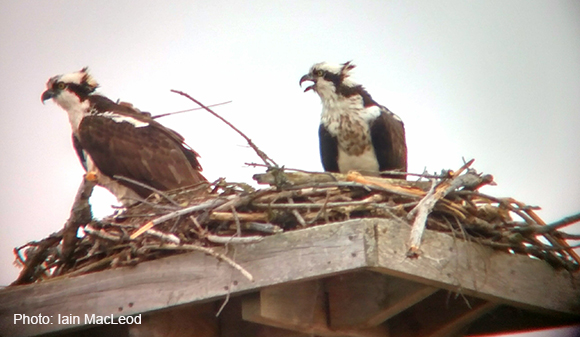 Wausau arrived at this nest in northern New Hampshire on the 18th. His arrival and the ensuing battle to resume ownership of "his" nest from a pretender to his throne was documented by Iain MacLeod, my partner in NH Osprey tagging. Wausau won the battle, in a scene reminiscent of what happened to Snowy twice on Nantucket this spring.
Wausau arrived at this nest in northern New Hampshire on the 18th. His arrival and the ensuing battle to resume ownership of "his" nest from a pretender to his throne was documented by Iain MacLeod, my partner in NH Osprey tagging. Wausau won the battle, in a scene reminiscent of what happened to Snowy twice on Nantucket this spring.
Nick, after spending the first week or so after his arrival over on the Virginia side of Chesapeake Bay is now back on Tangier Island full time. We'll try to get eyes on his nest area to see if he'll nest this year.
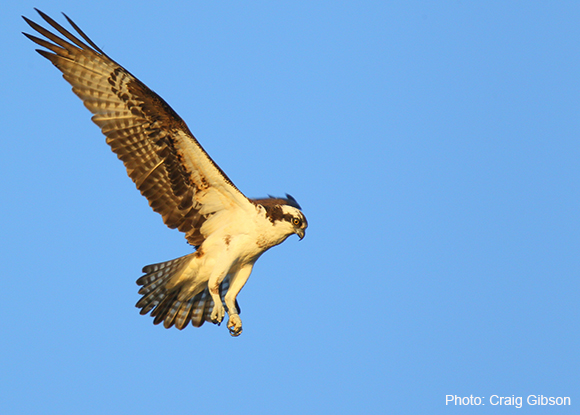
Craig Gibson photographed a tagged Osprey on Cape Cod. The bird is most likely Belle, and if it is, it means Belle is Beau! The bird certainly looks like a male, although it does have a bit of a chest band. The alternative is that it is a bird we tagged earlier in the study. Maybe it's Jaws or Conomo. We haven't seen the kinds of behavior from Belle that I've seen in other young males, where they prosptect for nest sites in the summer.
We'll know for sure when Belle finally finds a mate and settles down at a nest!
We lost the signal from Edwin, our peripatetic male tagged on Fishers Island. Very hard to tell with the cell-tower birds whether they've died or their transmitters have failed. Quin surprised me when he showed up at his nest on Tangier Island a couple of weeks after we got his last signal down in Georgia. With the satellite birds, we get signals from their radios when they stop moving, but if a cell-tower bird dies out of reach of a cell tower, we only know where it was when we got the last signal.
10 April 2016
All our adult birds except Wausau and Quin are home. Quin dropped off our radar screens over coastal Georgia back on 28 March. We'll watch his nest to see if he's there with a malfunctioning transmitter, but experience tells us that he probably died. With cell-tower birds we often can't tell what happened to them because they may have moved a long way after their last check-in.
Snowy left Cuba on the 12 March and arrived on the Cape seven days later. He went pretty much straight over to Nantucket, where he spent quite a bit of time last summer. Part of his antenna seems to have broken off, so he's OK, but we now only will hear from him when he happens to show up at a nest where someone notices him. He's been reported (and photographed) at two nests on Nantucket where he settled down with a female and was subsequently run off, probably by the resident males returning to that nest.
Belle is mostly over on the Cape, but has made two trips to Martha's Vineyard. We don't see her hanging out at a nest platform, so this may not be the year she finds Mr. Right.
Edwin's trip from the Brazilian rainforests began on 27 February and finished on 23 March. He spent some time at nest poles on Gardiners Island in Long Island Sound. He visited these poles last summer. This seems to be a pattern. Young birds will begin staking out possible nest sites in the summer and try them out the next spring, hoping that the owner doesn't make it back from the wintering area. He's now gallavanting around Connecticut, with no obvious fidelity to a possible nest site.
Staddler left his wintering area on 19 March and arrived at his nest in coastal NH on the 6th of April in an impressive 18 days, averaging 221 miles/day--a bird on a mission!
Nick left the Magdalena River valley in northern Colombia on 18 March and arrived at Tangier Island in Chesapeake Bay on the 30th. Since then he's been spending quite a bit of time over in Virginia on the western shores of the Bay.
Our 2014 juvenile Flow is still down in Cuba, where he has been for about 18 months. This will be his first trip north, and typically, young start their first trips in late April or even early May.
25 March 2016
Lots going on as all the adult birds are now on the wing or already home (Snowy and Edwin). Colors changed on the map again when Quin reappeared from his winter in Cuba.
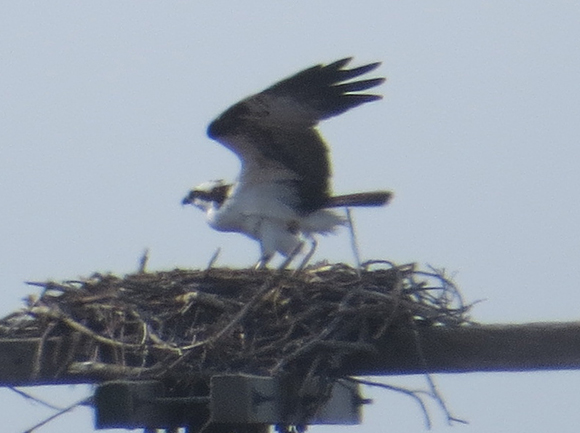 Snowy's transmitter (deployed way back in 2011) is beginning to fail. We missed an upload, but we have eyes on Snowy as he (see below) is trying to take over a nest on Nantucket. We've got pictures of him on the pole after he missed his upload, so we know it's the PTT, not the bird that's having problems. In this picture (taken by Trish Pastuszak), the antenna isn't visible, but it's obvious in another shot. This one shows a snow-white belly which makes me change my mind yet again on Snowy's gender. We first thought he was a male and then changed our minds based on his very early August departures--very much a female thing. But now he's back very early and looking very male. And very well fed. He has a huge crop (the big bulge in his chest) in this picture, which tells us he's just eaten a pretty big fish.
Snowy's transmitter (deployed way back in 2011) is beginning to fail. We missed an upload, but we have eyes on Snowy as he (see below) is trying to take over a nest on Nantucket. We've got pictures of him on the pole after he missed his upload, so we know it's the PTT, not the bird that's having problems. In this picture (taken by Trish Pastuszak), the antenna isn't visible, but it's obvious in another shot. This one shows a snow-white belly which makes me change my mind yet again on Snowy's gender. We first thought he was a male and then changed our minds based on his very early August departures--very much a female thing. But now he's back very early and looking very male. And very well fed. He has a huge crop (the big bulge in his chest) in this picture, which tells us he's just eaten a pretty big fish.
Edwin is back in southern Connecticut. We're hoping this year he'll get back to breeding. Last summer he spent a lot of time over on Gardiners Island. Watch for him to swing over there and check out the nest poles he was prospecting last year.
Nick and Quin only have to make it to Chesapeake Bay, so they should be home soon. The New Hampshire boys, Wausau and Staddler, still both in South America, better get a move on as they are missing out on an early spring up in central New England.
We're all pulling for Belle to get a move on and finally find Mr. Right. She last checked in (23 March) in central Florida. If the weather's been good, she should be in Georgia or South Carolina by now.
2014 juvenile Flow from northeastern Massachusetts is just a teenager, so we don't really expect him to wake up before noon, which translates in Osprey to begining his first migration north some time in April.
4 March 2016
Our favorite Osprey, Belle, is on the move! She's 4 days earlier than last year. Each year she has left earlier than the year before. Her first trip north, way back in 2012, began on Apr 13. The next year it was 25 Mar, then 14 Mar, then 8 Mar in 2015, and now 4 Mar. Maybe this year she'll get home in time to find Mr. Right. Talons crossed!
Edwin popped up in Venezuela. As in the past two summers, he wintered somewhere in the Amazon out of range of cell towers. In the 2013-14 and 2014-15 winters he was at the same spot along the Amazon. No reason to believe that this winter was different, and in fact there is every reason (every other adult Osprey we have followed) to believe that he went to the same spot. Last year he left his winter HQ very earlier (2 Feb) than any other bird we've followed. But he got up into southern Venezuela and then circled back and spent several weeks stalled out before heading north for real. This year he's 11 days ahead of last year's timetable.
Snowy will be very interesting to watch. She's the first bird we've seen with two winter homes--one in Cuba, where she is now, and one in Venezuela. Last year she wintered in Venezuela and left there on 20 Feb. This year, it's already 4 March and she hasn't started north. It was on March 4th last year that she got to her Cuban winter spot (where she is now). She stopped there for 27 days, starting the final push north on 31 March. This suggests that she somehow knows how far she is from home and thus when it's appropriate for her to start north.
Flow is gearing up for his first trip north after his 18-month stay in Cuba. First timers usually start late, so we don't expect him to move soon, but just stating this means he'll probably leave tomorrow! Talons crossed that he avoids fish farms in Cuba and Great-horned Owl woodlots on his way north.
26 January 2016
It has been a tough winter. Our Fishers Island male Charlie, who surprisingly popped up in December on Hispaniola, settled down at a fish farm in the D.R. and was almost certainly shot there. We had a couple of days of locations at the same spot at the edge of the fish farm and then nothing after 19 Dec., so we're pretty sure we lost him.
Prior to losing Charlie, we lost our signal from N.H. male Donovan on 10 November. He was in an apparently remote area where he's spent the winter before, so we don't know what might have happened to him. Then we lost a newly tagged N.H. male, Gundersen, whose last satellite update was on 12 January. Neither Donovan nor Gundersen showed a lot of transmissions from one spot, which is alway a sign of a dead bird, so we can hold onto a glimmer of hope that they'll show up at their nests in the spring, but experience tells us to expect the worst.
14 December
 Once again we have a December surprise. Normally by late October the adults are all settled down in their winter sites--the same ones they've used year after year. So this year, when our Fishers Island, NY, male Charlie did not show up at this winter HQ in northern Colombia, we assumed the worst. He's a cell tower bird, so we expect radio silence through Cuba, but we almost always pick these birds up as they come through Haiti and the D.R. Not a peep from Charlie though all of November, so it looked bad. And then on 13 December, we got an email data dump from him in the D.R. So, it turns out we don't know exactly how he got through the first bit of Cuba, but he left the Keys on 26 September and showed up in central Cuba on 22 Oct. (We may still get the data from the missing part of the trip in future downloads.) He spent 4 nights around 2 small reservoirs before moving to the Jimaguayu Reservoir on the 26th. Here, just 10 km north of the spot where our MA 2014 juvenile Flow has been biding his time, Charlie spent 38 days. Then, for reasons we'll never fathom, on 3 December he flipped on the migration switch again and headed southeast through the rest of Cuba. He made it over to Haiti on the 9th of December. He started south towards Cape Beata, launching pad for most adults crossing the Caribbean, but then turned northeast and is now in a heavily agricultural region in southwestern Dominica. We hope he keeps moving, as the Dominicans have proven rather trigger happy when it comes to our Ospreys. Where he was when we last heard from him is certainly not an Osprey-like habitat, so he was probably just moving over it. Keep watching the map!
Once again we have a December surprise. Normally by late October the adults are all settled down in their winter sites--the same ones they've used year after year. So this year, when our Fishers Island, NY, male Charlie did not show up at this winter HQ in northern Colombia, we assumed the worst. He's a cell tower bird, so we expect radio silence through Cuba, but we almost always pick these birds up as they come through Haiti and the D.R. Not a peep from Charlie though all of November, so it looked bad. And then on 13 December, we got an email data dump from him in the D.R. So, it turns out we don't know exactly how he got through the first bit of Cuba, but he left the Keys on 26 September and showed up in central Cuba on 22 Oct. (We may still get the data from the missing part of the trip in future downloads.) He spent 4 nights around 2 small reservoirs before moving to the Jimaguayu Reservoir on the 26th. Here, just 10 km north of the spot where our MA 2014 juvenile Flow has been biding his time, Charlie spent 38 days. Then, for reasons we'll never fathom, on 3 December he flipped on the migration switch again and headed southeast through the rest of Cuba. He made it over to Haiti on the 9th of December. He started south towards Cape Beata, launching pad for most adults crossing the Caribbean, but then turned northeast and is now in a heavily agricultural region in southwestern Dominica. We hope he keeps moving, as the Dominicans have proven rather trigger happy when it comes to our Ospreys. Where he was when we last heard from him is certainly not an Osprey-like habitat, so he was probably just moving over it. Keep watching the map!
And just when we thought we could relax for the winter and not be worrying about our birds.
19 November
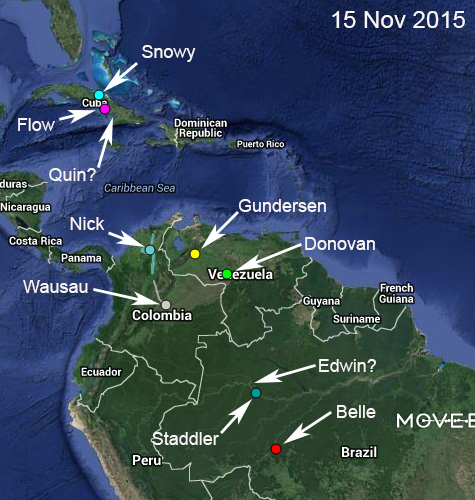 We lost our old friend and Long Island celebrity North-Fork Bob as he was migrating south over Florida. Thanks to Reinier Munguia of the Audubon Center for Birds of Prey, we recovered Bob's transmitter. All that was left of him were his wings out in a cattle pasture. There is a pair of Bald Eagles nearby so he may have had an encounter with an eagle, or he may have been picked off by a Great-horned Owl, which I think is more likely. Reinier reports that as Bald Eagles have become more and more abundant in central Florida, the number of Ospreys that are brought in to the rehab facility at the Audubon Center with broken limbs has been growing. These injuries are probably sustained when a Bald Eagle attempts to steal food from an Osprey. Given that Bob wouldn't have been carrying a fish when we lost him, I think it unlikely that an eagle would have harassed him, and if it had, an Osprey not carrying a fish can usually out maneuver an eagle. It looks like Bob had settled down at the edge of a stand of pines for the evening and was probably picked off by an owl.
We lost our old friend and Long Island celebrity North-Fork Bob as he was migrating south over Florida. Thanks to Reinier Munguia of the Audubon Center for Birds of Prey, we recovered Bob's transmitter. All that was left of him were his wings out in a cattle pasture. There is a pair of Bald Eagles nearby so he may have had an encounter with an eagle, or he may have been picked off by a Great-horned Owl, which I think is more likely. Reinier reports that as Bald Eagles have become more and more abundant in central Florida, the number of Ospreys that are brought in to the rehab facility at the Audubon Center with broken limbs has been growing. These injuries are probably sustained when a Bald Eagle attempts to steal food from an Osprey. Given that Bob wouldn't have been carrying a fish when we lost him, I think it unlikely that an eagle would have harassed him, and if it had, an Osprey not carrying a fish can usually out maneuver an eagle. It looks like Bob had settled down at the edge of a stand of pines for the evening and was probably picked off by an owl.
All our birds are settled down for the winter. Nick (Chesapeake Bay) is wandering around the Magdalena River valley much more than a typical adult. Usually, adults return to the same spot and move very little over their five month winter vacation. Of the three other cell-tower birds, Quin (Chesapeake Bay) and Edwin (Long Island Sound) are probably safe in their cell-tower-free winter ranges (Cuba and Amazonia, respectively), but I suspect we lost Charlie (Fishers Island) somewhere between Florida and Colombia. As I remember, he wintered in an area with cell-tower coverage, so his lack of signals suggests the worst.
New Hampshire male Donovan has missed two uploads, so he's either dead or his radio has failed. As a rule, when a transmitter just stops from one upload to the next, the bird is dead. We've never had a bird show up at a nest with a dead transmitter after a sudden loss of signal. We have had two radios die and seen the birds later (Jaws and Sr. Bones), but in both cases the radios sputtered--coming on and off--before we finally lost signal. Donovan's radio is in its 4th year, so that gives us some hope--it's the same time frame that we lost the signal from Sr. Bones. We'll have to wait for spring to see if Donovan shows up at his nest in Tilton, NH. Keep your talons crossed.
All the other birds seem to be doing fine. Flow (northeastern MA) will be coming home for the first time in about five months.
20 October
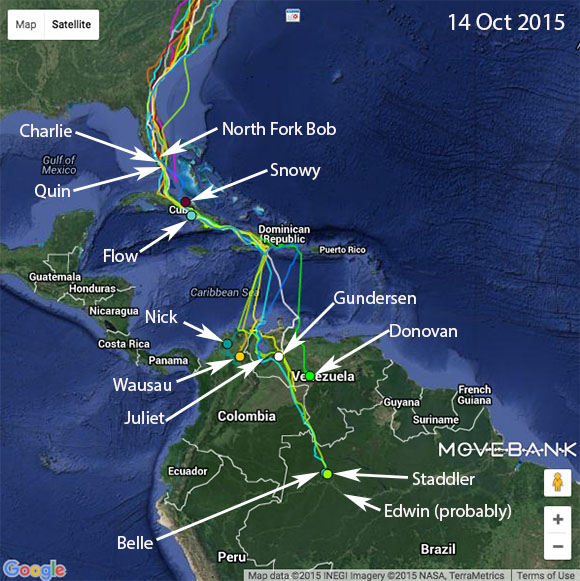 Nick (a Tangiers Island male) got back to his winter area in the Magdalena River valley. He arrived on 29 Sept, just 12 days after leaving the Chesapeake Bay. He is exhibiting some unusual behavior. He arrived at his wintering area in the Magdalena valley and has made two rather substantial "road trips" wandering away from his regular spot. Most adults get back to their winter HQ and stay put for the duration.
Nick (a Tangiers Island male) got back to his winter area in the Magdalena River valley. He arrived on 29 Sept, just 12 days after leaving the Chesapeake Bay. He is exhibiting some unusual behavior. He arrived at his wintering area in the Magdalena valley and has made two rather substantial "road trips" wandering away from his regular spot. Most adults get back to their winter HQ and stay put for the duration.
Quin, our second male from Tangiers Island, was last heard from on the 8th, crossing Key Largo--just 2 miles from the hotel I was staying in at the time. He won't have made it to the Caribbean yet, but is somewhere in Cuba.
See the New England Fall page for updates on the rest of the flock.
28 September 2015:
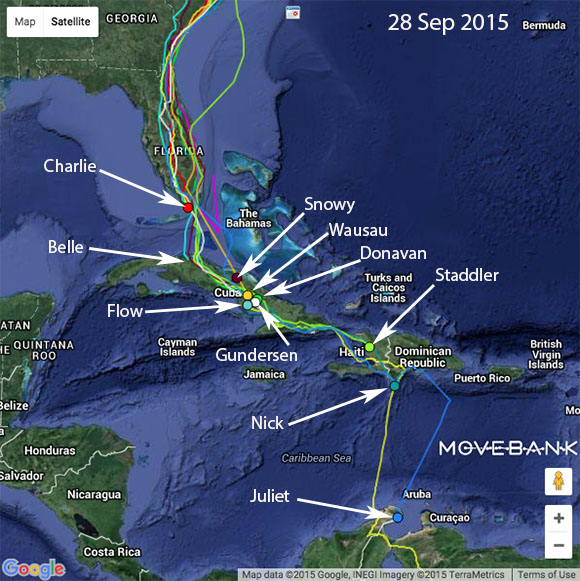 One of our two surviving Chesapeake birds, Nick crossed the Caribbean and is almost back at his winter home in the Magdalena River Valley in Colombia. Quin is still on Tangier Island. Last year he left on 26 Sept. so as of this update, he's two days behind schedule.
One of our two surviving Chesapeake birds, Nick crossed the Caribbean and is almost back at his winter home in the Magdalena River Valley in Colombia. Quin is still on Tangier Island. Last year he left on 26 Sept. so as of this update, he's two days behind schedule.
As for the New England flock, we've lost Artoo between Florida and Cuba. The pink track going north was probably him on a boat going north, and then at the end, apparently his body floating in the Florida Current. We have no idea what might have happened to him. There's no indication that there was any severe weather in the area, so this is a complete, and very frustrating mystery. We're not supposed to get attached to our study subjects, but we do. It's especially frustrating when a young bird makes it through the tough first migration cycle and then is lost on its second trip south.
All the New Hampshire birds are on the move. Juliet is the first across the Caribbean and is safely on the Guajira Peninsula. This is her first trip, so neither she nor we know where she's going. After his departure on 20 Sept (2 days later than last year), Donovan caught up with Wausau and Gundersen in central Cuba, where there is a New Hampshire traffic jam. Staddler is over in Haiti.
In Long Island Sound, Fishers Island male Charlie also started south on the 20th, leaving North Fork Bob as the winner of the New England "Last one out, turn off the lights" award this year. Charlie's last signal was in southern Florida. By now he's somewhere in the cell-tower black hole of Cuba.
Snowy is holding tight at the Laguna de la Leche. Still taking bets on whether she's going to spend the whole winter there as she did in 2013-14, or move on to her Venezuelan winter home as she did last winter. It's looking more and more like she's going to stay there, which is fine by me! She's precious cargo for us now as the second longest surviving tagged juvenile (behind Belle) and I don't want her crossing the Caribbean.
15 September 2015:
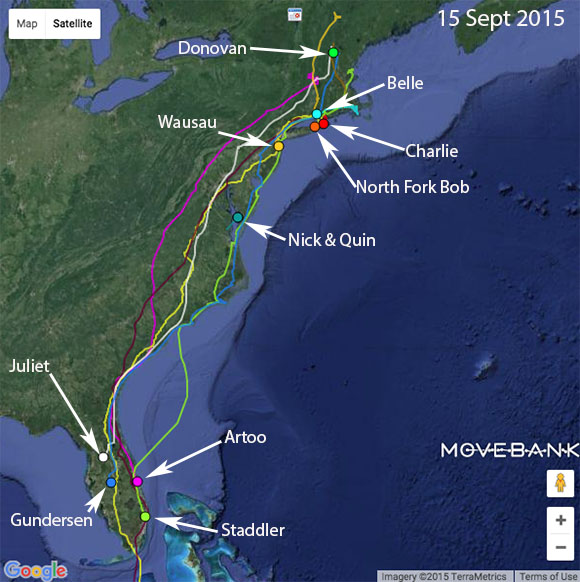 The cool, crisp weather and north winds have convinced a few more birds to get moving. Wassau left his nest area in central New Hampshire on the 11th and is now in northern New Jersey. He might get counted at the Cape May Hawk Watch in a day or so. Belle got going on the 15th, four days earlier than her start back in 2014.
The cool, crisp weather and north winds have convinced a few more birds to get moving. Wassau left his nest area in central New Hampshire on the 11th and is now in northern New Jersey. He might get counted at the Cape May Hawk Watch in a day or so. Belle got going on the 15th, four days earlier than her start back in 2014.
We've got four New Hampshire birds in Florida now: Artoo (2013 juvie on 2nd trip south), Staddler and Gundersen (newly tagged adult males), and Juliet (newly tagged juvie on her 1st trip south. Our other New Hampshire bird, Donovan, is going for the "last one out, turn off the lights" award.
Around Long Island Sound, Charlie (Fishers Island male) is spending a lot of time on Gardiners Island, just as he did last year before taking off, so I suspect he'll leave soon. North Fork Bob seems to like his new nest and can't seem to tear himself away from it. They should both leave soon(ish).
Our two veteran males from the lower Chesapeake Bay (Nick and Quin) have been staying very close to home. They started south last year on the 18th and 26th, respectively.
2 September 2015:
Our first bird is across the Caribbean--well almost across. When he downloaded (at 1:30 PM on 2 Sept) he was 10 miles from the Colombian coast. He left the D.R. at 6:28 PM on the 1st and 19 hours later had covered 386 miles, which is almost exactly 20 mph (33 kph). The crossing was made "down on the deck." His average altitude on the crossing was 17 m (51 feet). Only once was more than 30 m over the water.
1 September 2015:
Sadly we lost our very interesting juvenile, Lizzie, probably to electrocution. She was found right below some high tension wires near her adopted nest. Details on the New England page.
24 January 2015:
It's not usual to get a surprise in the middle of the winter. At least it wasn't when we had only satellite transmitters on our Ospreys. Now that some of our birds carry cell-tower transmitters, we occasionally have birds pop up after long silences when they wander into an area with celll tower coverage. This is what happened with Crabby, a female we tagged on Kent Island in Chesapeake Bay last spring.
In the fall, Crabby migrated to the northeastern coast of South America. She arrived in French Guiana on October 4th. It looked like she was going to settle down there. Then, just a day later, we stopped getting signals from her. I was worried because it did look like she had settled down, so we shoud have continued to get sporadic messages from her over the course of the winter. She was on the outskirts of Cayenne, the capitol of French Guiana. So that suggested cell coverage should be good, but it also meant she might have a high likelihood of being shot.
After 3 months with no signals, I assumed she was dead or had just moved to a spot without cell coverage (there's much more down in South America than one would expect). In either case, we probably would have to wait until spring when she either showed up again somewhere along her migration route, or just never reappeared, which would have meant something had happened to her.
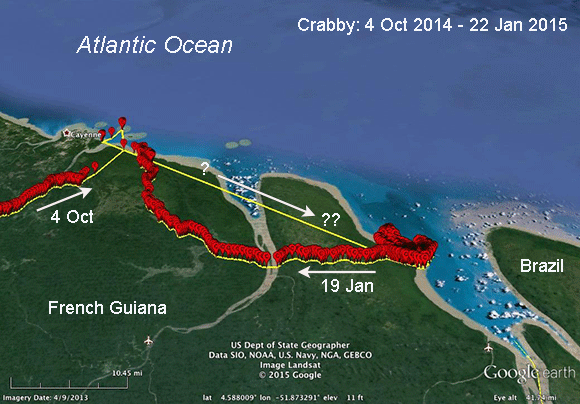
So it was a nice surprise to get an email with data from a transmitter number I didn't recognize. (Each message from a cell-tower bird has the ID of the bird.) It had been so long since I'd heard from her that I had to look up the number.
We're missing some data. We don't have any locations from Oct 6th through Dec 20th, so we don't know when she moved down, but from at least the 20th of December to th 19th of January, she was along the coast 50 mi. (80 km) southeast of Cayenne and 10 miles west of Brazil's northernmost state of Amapa.
14 November:
This map begins on 1 October. At that time, Artoo (juvenile tagged in 2013) was moving around a bit, but basically settled down (he'll come back next spring), Snowy (MVY bird from 2011) had returned to her winter range from 2011-2012, Woody was back west of Lake Maracaibo in Venezuela, Clyde (2014 young from Long Island) seems to have settled down on the eastern shores of the Gulf of Venezuela, and Bridget is showing all signs that she thinks Vero Beach, FL, is a good place to spend the next 18 months.
Flow (2014 juvenile from Essex, MA) hadn't really started migrating with any conviction yet and was still up around Chesapeake Bay, North Fork Bob (always a late starter in the fall) was in western Cuba, Belle (tagged as a juvenile on Martha's Vineyard in 2010), Charlie (Fishers Island adult male tagged in 2014), and Ron (adult male tagged in Washington, DC in 2013) were all within about 80 miles of each other in southeastern Cuba.
By 14 November, it seems almost everyone has settled down for the winter. North Fork Bob did his usual thing of stopping for a while in the flooded grasslands (llanos) of central Venezuela. He's now moving up into the highlands of the Guiana Shield, where he has spent all his previous winters along the Ventuari River. His radio missed a few transmissions, so I won't be surprised if we lose track of him like we did last year with his 2010 Classmate Sr. Bones. The youngsters (Bridget, Flow, and Clyde) may move again, but I'd be very surprised if they make any major moves south.
